Trying to save one of the rarest species on Earth takes an emotional toll on you.
“It’s horrible,” says Captain Oona Layolle. “It’s really hard on everyone in the crew.”
Layolle is the campaign leader for the Sea Shepherd Conservation Society’s Milagro III mission, which just returned from the Gulf of California after a six-month effort to save the critically endangered vaquita porpoise (Phocoena sinus) from extinction. The most important part of their mission — a partnership with the Mexican government — involved finding and removing illegal gillnets set by fishermen to capture another local species, the totoaba (Totoaba macdonaldi), whose swim bladders that sell for thousands of dollars a pound to Chinese investors. The indiscriminate gillnets, set and anchored into place, capture and kill totoaba, vaquita and everything else that crosses their paths.
“I have never in my life seen so many dead animals,” says Layolle. “Whales, dolphins, sharks, sea turtles…it’s crazy. We see the dead every day.” She sighs. “It’s gotten so it’s almost kind of normal to me now.” All told this year the Milagro crew pulled 1,195 dead animals from 233 illegal nets and fishing lines.
The list of the dead includes five dead vaquita, a species whose population had already declined to just 30 animals by the end of last year and which may fall to as few as 15 by 2018.
“A dead vaquita is the last thing we want to see,” Layolle says. “I’ve seen more dead than alive.” At least one of this year’s dead vaquita was a newborn or fetal animal, possibly pushed out by its mother in a vain attempt to save it from death in a net.
The nets weren’t the only place they found dead animals. At the end of the mission, the crew walked the 27 kilometers of beach between the Mexican towns of San Felipe and Santa Clara and found themselves on a killing field. “The beach of San Felipe was littered with the bones of totoaba,” Layolle reports. “We photographed and measured 384 totoaba heads.” The bodies were all that remained after fishermen carved out the totoabas’ valuable swim bladders.
But even amidst this catastrophic level of mortality, life persists. Sea Shepherd rescued nearly 800 live animals from nets this year, including several totoaba, many of which barely clung to life by the time they were discovered. “When we find them, most of the time they are dying,” Layolle says. “So we have to do a massage, kind of, move it back and forth with water on the lungs. Usually they just start swimming.”
They weren’t lucky enough to save any vaquita from nets, but Layolle recounts one emotional encounter toward the end of this year’s mission. “It was just when we were getting ready to turn back,” she says. “It was a very calm day, the third day in a row with no illegal fishing during the daytime. We were drifting. Suddenly a vaquita came into view of our ship. It was kind of like a call, like she was saying ‘don’t ever leave.’
“It’s so magical to see such a rare animal,” she continues. “I always remember that on the hard days.”
Despite the difficulty of their work, Layolle stands firm in her belief that their mission matters. “When I started this campaign, a lot of people told me there was no point to do it because the vaquita was already nearly gone. But I actually think it has been really important because they can’t go extinct without anyone knowing. And it can’t happen again to any other species.”
Beyond that, she feels her team has made a difference for the wildlife in the Gulf of California. “I know finding these nets has saved so many species that would have died in them,” she says. “Maybe if we hadn’t retrieved all of those nets the vaquita would already be gone.”



3 thoughts on “The Last Vaquitas: “I’ve Seen More Dead Than Alive””
Comments are closed.